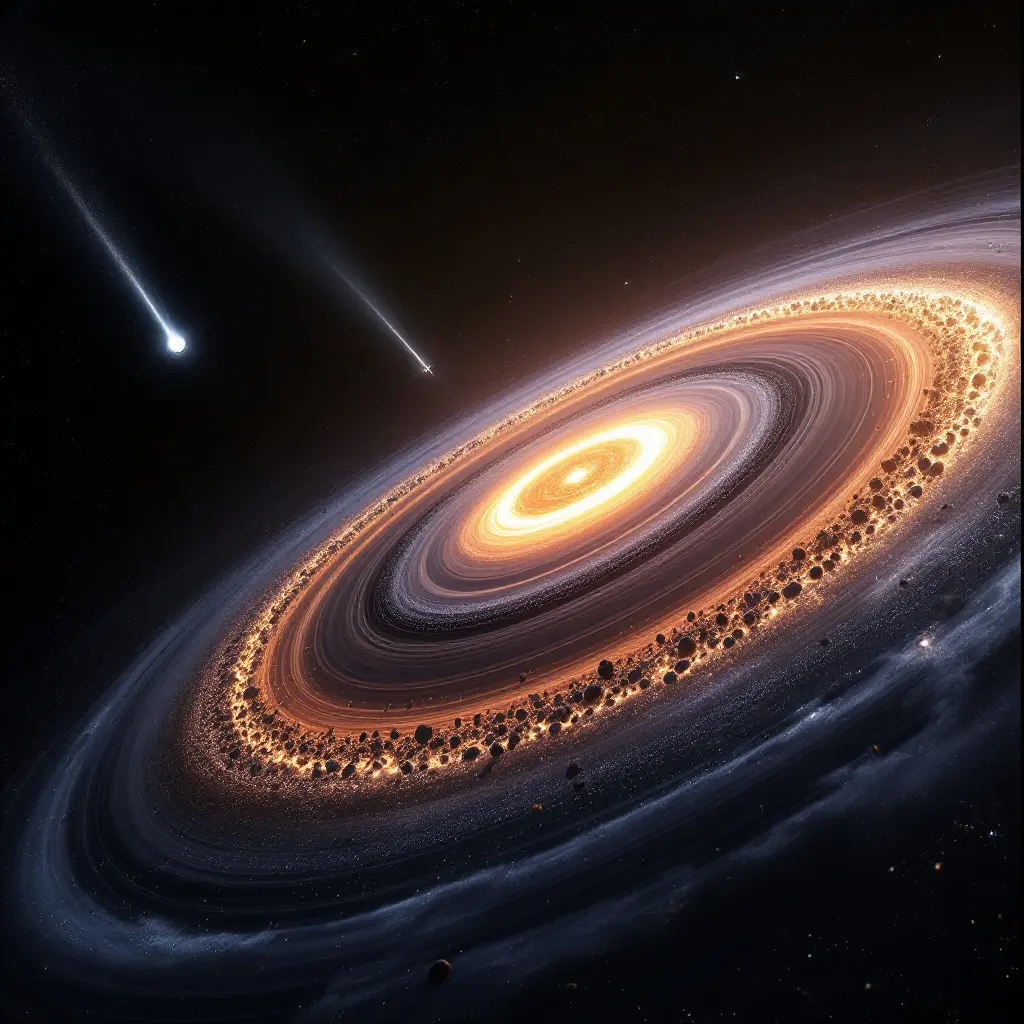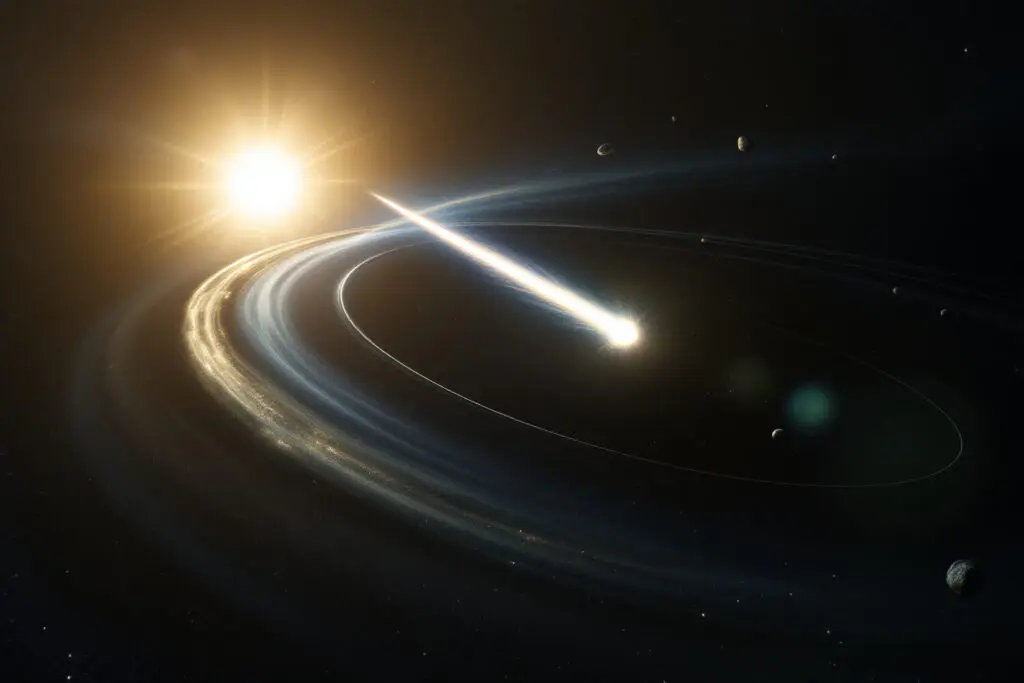Look up on a clear night. You’re seeing more than just twinkling stars. You’re looking into a cosmic highway, full of silent travelers. I’m talking about comets, with their spectacular tails, and asteroids, the leftover rubble from when our solar system was born. They aren’t just drifting. Not at all. Every move they make is guided by an invisible, powerful force. Getting a handle on the trajectory of comets and asteroids isn’t just for astronomers.
It helps us understand the huge, intricate dance happening right over our heads. It’s a story about gravity, pure speed, and every now and then, a shove that changes everything. People say, ‘it’s not rocket science,’ but in this case, it kind of is. Don’t worry, though. I’m going to break it all down, simple and clear.
More in Celestial Mechanics Category
Key Takeaways
- Gravity Runs the Show: Gravity is the boss. The Sun’s massive pull is the main driver, but big planets like Jupiter get a say, too.
- Their Paths Aren’t Random: These rocks and ice balls follow predictable paths, usually ovals (ellipses). Some are just passing through on one-way trips, never to be seen again.
- Comets vs. Asteroids: They follow the same rules, but their routes are wildly different. Comets take long, dramatic trips from the frozen edge of the solar system. Most asteroids stick to a more stable, circular commute in the main asteroid belt.
- Paths Can Change: A close fly-by of a planet can sling a comet or asteroid onto a totally new course. Sometimes, that new course is closer to us.
- We’re Watching for a Reason: Tracking these paths isn’t a hobby; it’s planetary self-defense. Knowing where they’re going lets us predict impacts and figure out how to give them a nudge if we have to.
So, What Exactly Steers These Cosmic Wanderers?
It all comes down to one thing: gravity.
Seriously, that’s the whole secret. From a planet’s clockwork orbit to a comet’s dramatic sweep across the sky, it’s all because of the invisible, relentless pull of gravity. When Sir Isaac Newton figured out his law of universal gravitation back in the 17th century, he basically handed us the rulebook for the cosmos. He saw that anything with mass pulls on everything else with mass. The bigger it is, the stronger it pulls. And the closer you get, the stronger that pull becomes.
For a comet or an asteroid, this means it’s in a constant gravitational tug-of-war with the Sun, the planets, and even other small bodies. Its trajectory is simply the path it carves through that complex web. Imagine a bowling ball on a stretched-out rubber sheet. If you roll a marble nearby, it won’t go in a straight line. It’ll curve around the dip made by the bowling ball. That’s a pretty good way to picture what’s going on.
Is It Just One Big Pull from the Sun?
Pretty much. The Sun is the heavyweight champ of our solar system, no contest. It makes up over 99.8% of all the mass around here, so its gravity easily overpowers everything else. This is why everything—planets, asteroids, comets—orbits the Sun. It’s the bowling ball on the rubber sheet.
But the exact path an object takes boils down to its speed and direction. The trick is having the right amount of speed for your distance. Too slow, and you’ll spiral into the Sun. Too fast, and you’ll escape its gravity and fly off into deep space. But if you have that ‘just right’ speed, you fall into a stable orbit. You’re constantly falling toward the Sun, but you have enough sideways motion that you always miss. That perfect balance between speed and gravity is what defines the trajectory of comets and asteroids.
Are All Their Paths the Same Shape?
You probably picture orbits as nice, neat circles. In the real world, that’s almost never the case. The paths these objects take are what mathematicians call “conic sections.” If you slice through an ice cream cone, you can get four different shapes depending on the angle of your cut: a circle, an oval (ellipse), a parabola, or a hyperbola. Those are the only four shapes an orbit can be.
A circle is just a very specific, perfectly balanced ellipse. Because perfection is rare in the cosmos, most orbits are ellipses—a bit stretched or squashed. But those other two, parabolas and hyperbolas, tell a wilder story. They’re the sign of a cosmic tourist who’s just passing through. It all depends on how much energy the object is packing.
Why Do Most Comets Keep Coming Back?
The comets we see over and over, like the famous Halley’s Comet, are trapped in elliptical orbits. They’re gravitationally chained to the Sun, so their path is a closed loop. They swing way out into the frozen depths of the solar system, slow to a crawl, and then gravity inevitably reels them back in. They whip around the Sun at incredible speed and get flung back out to start the long journey all over again.
An ellipse has two center points, or “foci.” The Sun always sits at one of them. That means the comet or asteroid is on a path that takes it both near the Sun and far away.
- Perihelion: This is the closest point to the Sun. Here, the object is moving at its absolute fastest.
- Aphelion: This is the farthest point. The object is at its slowest here, hanging for a moment before the Sun’s gravity pulls it back.
The time to complete one circuit is the orbital period. For Halley’s Comet, it’s about 76 years. For long-period comets coming from the fringes of the solar system, a single lap can take thousands or even millions of years.
What About a “One-Time Visit”?
But what if an object isn’t tied down by the Sun’s gravity? This can happen if a comet gets knocked out of the far reaches of the solar system, or if it’s an interstellar object visiting from a completely different star system. These travelers have so much speed that our Sun’s gravity can’t capture them. They’re on an escape path.
Their trajectories are either parabolic or hyperbolic. A parabola means it has the bare minimum speed needed to escape. A hyperbola means it has speed to spare. Either way, the story ends the same: they scream into the solar system, loop once around the Sun, and shoot back out into the blackness, never to return. The mysterious object ‘Oumuamua, spotted in 2017, followed a clear hyperbolic path, proving it was just a tourist in our cosmic neighborhood.
What’s the Difference Between a Comet’s Path and an Asteroid’s?
While they both play by the same rules of gravity, their typical flight paths tell you a lot about where they came from. If asteroids are the orderly, predictable citizens of the inner solar system, comets are the wild, dramatic travelers from the hinterlands. This all comes down to their home turf and the gravitational nudges they’ve gotten over billions of years.
The main difference is their orbital “eccentricity”—a fancy word for how stretched-out their orbit is. An eccentricity of 0 is a perfect circle. Anything between 0 and 1 is an ellipse. The closer you get to 1, the more it looks like a long, skinny oval.
Why Are Comets Such Drama Queens with Their Long, Sweeping Orbits?
Comets are basically dirty snowballs. They come from two places, both in the freezing boondocks of our solar system: the Kuiper Belt (a ring of icy bodies out past Neptune) and the Oort Cloud (a huge, spherical shell of comets that surrounds everything else, almost a light-year away).
Since they come from so far out, their orbits tend to be extremely eccentric. A comet can spend millennia crawling through the darkness near its aphelion, then accelerate like a rocket as it plummets toward the Sun. This close, scorching pass is what gives a comet its tail. The Sun’s radiation boils off its ice and dust, and the solar wind blows the debris away from the Sun, creating the glowing coma and tail. That whole spectacular show only happens because its trajectory brings it so near our star.
And Why Are Asteroids More… Predictable?
Most asteroids, however, lead much quieter lives. The huge majority of them hang out in the main asteroid belt, a vast stretch of space between Mars and Jupiter. They’re the raw materials for a planet that never got built, thanks to Jupiter’s massive gravity stirring things up.
Asteroids in the belt generally have orbits that are much more circular (low eccentricity). They travel in a flat plane alongside the planets, mostly keeping to themselves. They are the quiet remnants of a failed planet, circling the Sun in a relatively orderly fashion. Of course, there are always rebels. Some asteroids, called Near-Earth Asteroids (NEAs), have been knocked into orbits that cross ours. Those are the ones we watch very, very carefully.
Can a Planet Throw a Wrench in the Works?
You bet. The Sun may be the director, but the planets are powerful actors that can change the script. A close fly-by of a planet can give a passing comet or asteroid a gravitational kick, known as “gravitational perturbation,” sending it onto a completely new course. It’s a solar system-sized game of pinball.
This isn’t some rare event; it’s a constant, vital part of how the solar system works. These gravitational nudges shaped everything we see today. They’ve scattered asteroids, flung comets toward the Sun, and may have even delivered water and the ingredients for life to early Earth. The dance of gravity never stops.
How Does a Giant Like Jupiter Act Like a Celestial Bouncer?
Jupiter is the biggest player on the board besides the Sun. Its gravity is so powerful it acts as a gatekeeper for the whole solar system. In one sense, it’s our protector. Jupiter has probably thrown countless comets and asteroids out of the solar system entirely, or taken the hit itself, shielding Earth from impacts. We saw this firsthand in 1994 when Comet Shoemaker-Levy 9 slammed into Jupiter in a series of spectacular fireballs.
But Jupiter’s pull can also be a threat. It can nudge an asteroid out of the stable main belt and send it tumbling toward the inner planets, including us. Its gravity can also perform a “slingshot” maneuver. We’ve used this for our own space probes. A gravity assist lets a spacecraft borrow a little of a planet’s orbital energy to get a massive speed boost, flinging it toward the outer solar system for free.
Can Even a Small Nudge Make a Big Difference?
When you’re talking about millions or billions of years, the smallest push can have enormous consequences. It’s the butterfly effect on a cosmic scale. A tiny nudge today could mean the difference between a near miss and a direct hit a million years from now.
And it’s not just gravity. There are other, sneakier forces at work. Take the Yarkovsky effect. As a dark asteroid spins, its sun-facing side heats up. When that hot spot rotates to the dark side, it radiates heat into space. This acts like a minuscule, invisible thruster. It’s an incredibly weak push, but over millions of years, it’s enough to alter an asteroid’s orbit, causing it to drift. It’s a subtle reminder that the universe is always in motion.
How Do We Actually Track the Trajectory of Comets and Asteroids?
Figuring out the path of a small, dark rock millions of miles away, moving at highway speeds, is a monumental task. It’s a high-stakes detective story that starts with a single, faint dot of light moving against the fixed background of stars. Scientists all over the world are dedicated to this work: finding them, tracking them, and figuring out what they’re made of.
The technology has come a long way. We’ve gone from astronomers squinting through eyepieces to robotic telescopes that automatically scan the entire sky every few nights. This global network is our planet’s early-warning system.
What Are We Looking for in the Sky?
First, you have to find them. Big survey telescopes take thousands of pictures of the sky. Software then meticulously compares those pictures, looking for any dot that has moved. That’s the first clue.
Once a computer flags a potential object, the human detectives take over. Astronomers have to make follow-up observations to confirm it’s a real object and not a glitch. Using telescopes around the world, they take precise measurements of its position and brightness. The more measurements they get, the better they can pin down its path.
Once We Spot One, How Do We Predict Its Future Path?
It only takes a few data points to calculate a rough, preliminary trajectory. This gives astronomers a small piece, or “arc,” of the object’s full orbit. They plug that arc into computers that use the laws of gravity to project the most likely full path. Is it an ellipse? Will it return? And most importantly, where will it be next year, or next century?
All this information goes to one place, the Minor Planet Center (MPC), which keeps the official catalog. As more observations roll in, the calculated orbit gets more and more precise. The uncertainty shrinks until we can predict an object’s future position with astonishing accuracy. That’s how we know, for example, that a specific asteroid will fly safely past Earth in the year 2077.
Why Does All This Matter to Us on Earth?
This isn’t just an academic puzzle. Mapping these trajectories is a matter of survival. We live in a cosmic shooting gallery, and while a big impact is unlikely in our lifetime, the consequences are too great to ignore. The dinosaurs didn’t have a space program.
They couldn’t see it coming. We can. This knowledge means we don’t have to be helpless. We can be guardians of our own planet. It’s a heavy responsibility, and it’s why scientists work so hard to find every last one of these rocks. Every new discovery helps complete the map and keep us safe.
Are We Playing a Cosmic Game of Dodgeball?
You could say that. The mission is to know where everything is and where it’s headed. An asteroid is labeled a “Potentially Hazardous Asteroid” (PHA) if its orbit brings it within about 4.6 million miles of ours and it’s bigger than about 460 feet across. An impact from an object that size could wipe out a city or cause tsunamis.
Finding these PHAs is job number one for planetary defense. The great news is we’ve found over 90% of the truly huge, dinosaur-killer-sized ones, and none are on a collision course. The hunt is now on for the smaller, but still very dangerous, ones.
And we’re not just watching anymore. In 2022, NASA’s DART mission proved we can fight back. A refrigerator-sized spacecraft intentionally slammed into a small asteroid and successfully changed its orbit. It was a historic first—humanity flexing its muscle on a cosmic scale. It proved that if we have enough warning, we can give a dangerous asteroid a little push to make sure it misses.
It all comes back to the trajectory. By understanding this intricate dance of gravity, we can not only marvel at the universe but also protect our home within it.
FAQ – Trajectory of Comets and Asteroids

Why is it important to monitor the trajectories of comets and asteroids?
Monitoring the trajectories of comets and asteroids is crucial for planetary defense, as it allows us to predict potential impacts with Earth and take measures to prevent or mitigate possible collisions, safeguarding our planet from catastrophic events.
How do scientists track and predict the future paths of these space objects?
Scientists track the paths of comets and asteroids using telescopic observations to gather data on their position and movement. They then use computer models based on gravitational laws to predict future trajectories, refining their predictions as more data becomes available.
How can the paths of comets and asteroids change over time?
The paths of comets and asteroids can change due to gravitational perturbations from close encounters with planets, especially giants like Jupiter, or subtle forces like the Yarkovsky effect, which is caused by the way an asteroid absorbs and radiates heat.
Why do most comets have long and dramatic orbits while asteroids tend to have shorter, more predictable paths?
Most comets have long, eccentric orbits because they originate from the distant, icy regions of the solar system, such as the Oort Cloud, and their paths are heavily influenced by gravitational interactions. In contrast, asteroids in the main belt have more circular, stable orbits due to their location and the gravitational effects of nearby planets like Jupiter.

